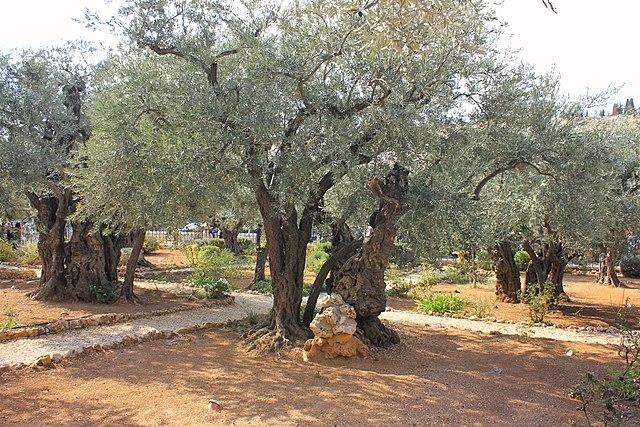They went to a place called Gethsemane; and he said to his disciples, “Sit here while I pray.” He took with him Peter and James and John, and began to be distressed and agitated. And he said to them, “I am deeply grieved, even to death; remain here, and keep awake.” And going a little farther, he threw himself on the ground and prayed that, if it were possible, the hour might pass from him. He said, “Abba, Father, for you all things are possible; remove this cup from me; yet, not what I want, but what you want.”He came and found them sleeping; and he said to Peter, “Simon, are you asleep? Could you not keep awake one hour?Keep awake and pray that you may not come into the time of trial; the spirit indeed is willing, but the flesh is weak.”And again he went away and prayed, saying the same words.And once more he came and found them sleeping, for their eyes were very heavy; and they did not know what to say to him. He came a third time and said to them, “Are you still sleeping and taking your rest? Enough! The hour has come; the Son of Man is betrayed into the hands of sinners. Get up, let us be going. See, my betrayer is at hand.”
New Revised Standard Version Bible: Catholic Edition, copyright © 1989, 1993 the Division of Christian Education of the National Council of the Churches of Christ in the United States of America. Used by permission. All rights reserved.
What to do with this educator’s commentary
This commentary invites you as a teacher to engage with and interpret the passage. Allow the text to speak first. The commentary suggests that you ask yourself various questions that will aid your interpretation. They will help you answer for yourself the question in the last words of the text: ‘what does this mean?’
This educator’s commentary is not a ‘finished package’. It is for your engagement with the text. You then go on to plan how you enable your students to work with the text.
Both you and your students are the agents of interpretation. The ‘Worlds of the Text’ offer a structure, a conversation between the worlds of the author and the setting of the text; the world of the text; and the world of reader. In your personal reflection and in your teaching all three worlds should be integrated as they rely on each other.
In your teaching you are encouraged to ask your students to engage with the text in a dialogical way, to explore and interpret it, to share their own interpretation and to listen to that of others before they engage with the way the text might relate to a topic or unit of work being studied.
Structure of the commentary:
See the general introduction to Mark.
Text & textual features
Characters & setting
Ideas / phrases / concepts
Questions for the teacher
The world in front of the text
Questions for the teacher
Meaning for today / challenges
Church interpretations & usage
The World Behind the Text
See general introduction to Mark.
The world of the text
Text & textual features
The account, structured as a narrative, has been referred to historically by different titles included Agony in the Garden and Betrayal in the Garden. It’s title here, Jesus prays in Gethsemane, directs us to the content of the story.
The passage has two settings: in time, the event occurs in the days before Jesus’ crucifixion and immediately after Jesus’ celebration of the Passover (Last Supper); geographically it occurs on the Mount of Olives in a garden named Gethsemane.
This is perhaps the best example of a passage which shows, most vividly, Jesus’ vulnerability. Up to this moment, Jesus has made clear he will suffer and die; in this passage we see the fear that comes with this knowledge. Jesus ‘distressed’, ‘agitated’ and ‘deeply grieved, even to death’ asks his friends to ‘keep awake’. This may be an allusion to the parable (Mark 13:32-37) which calls for the need to stay awake and be ready for coming of the Kingdom.
Jesus prays, calling God ‘Abba’ – the Aramaic word for Father and in this usage, an intimate term – to take this cup away from him, showing his humanity. Yet even in this, Jesus says that if that is truly what God wants then so be it.
To Jesus’ great disappointment, each of the three times he comes back to his friends he finds them asleep. This three-fold failure again alludes the three-fold denial Peter will make shortly. Let down in this moment by those who should have been closest to him, those to whom he has trusted his most intimate sense of self, Jesus seems to submit to what is to come and the Passion story unfolds. Indeed, in the last sentence Jesus says to Peter, James and John, “get up, let us be going”. Despite their failures and weakness, they are invited to follow Jesus on this final journey as he moves toward the cross.
Characters & Setting
Peter, James and John
The discipleship circle is made up of different groups: the twelve, reminiscent of the 12 tribes of Israel, and the wider, larger circle, inclusive of men and women. These three, Peter, James and John form an inner circle of the 12: taken with Jesus for ‘special’ teaching, they were with him at the transfiguration and the raising up of Jairus’ daughter. They, therefore, form a tight core ‘leadership’ group close to Jesus. That they would fail him at his hour of need, is, consistent with Mark’s overall view of the 12: they do not understand either who Jesus is or the demands of discipleship.
Simon
Simon, also known as Simon Peter, and just Peter, a name given to him when he becomes a disciple. Note the strange, inconsistent, use of his name in the passage: that Mark says that Jesus calls him Simon may be to heighten attention to the fact that he still seems not to understand what being a disciple means.
Gethsemane

The garden of Gethsemane is a garden at the foot of the Mount of Olives just outside Jerusalem. The word gethsemane means ‘olive press’ indicative of the olive trees growing there and the large ‘press’ used to squeeze out the oil. Although retreating to pray after the Passover meal was part of the ritual, Mark suggests that it would have been a fairly quiet place for Jesus to pray.
Ideas/phrases/concepts
“Cup”
By Jesus’ reference to his suffering as ‘this cup’ he links the story to the Passover (Last Supper) which just prior to this story, Mark has described as ‘the blood of the covenant’ (Mk 14:24).
Questions for the teacher:
The world in front of the text
Questions for the teacher:
Please reflect on these questions before reading this section and then use the material below to enrich your responsiveness to the text.
Meaning for today/challenges
In this narrative Jesus is more than vulnerable – he is what we would commonly say is ‘desperate’. He has no desire to suffer and die but submits fully to God. This picture of Jesus is low Christology: before being divine Christ knows the fear, pain and betrayal of the human condition. Luke, and John will write this vulnerability out of their own portraits of Jesus.
How does this relate to us today? God does not ask many for martyrdom and for many, taking the time to stop and listen to what God is calling them to is not a regular part of life.
Perhaps for many there is a connection in that Jesus makes himself absolutely vulnerable in this story in front of his friends. He says to them “I am grieved, even to death”. He lays bare his feelings and fears and then despite their failings, invites Peter, James and John to accompany him on his final journey.
How often do we open ourselves up to others, truly let them know how we are travelling, how we are feeling? How often do we let others in to accompany us and not just ‘tough it out’?
And in these moments of hardship, do we invite God to walk with us?
Church interpretation & usage
In the Compendium of the Catholic Church it tells us:
“The prayer of Jesus during his agony in the Garden of Gethsemane and his last words on the Cross reveal the depth of his filial prayer. Jesus brings to completion the loving plan of the Father and takes upon himself all the anguish of humanity and all the petitions and intercessions of the history of salvation. He presents them to the Father who accepts them and answers them beyond all hope by raising his Son from the dead” (n. 543).
Liturgical Usage
This reading is used most notably on Palm Sunday in Year B as a part of the Passion readings.
